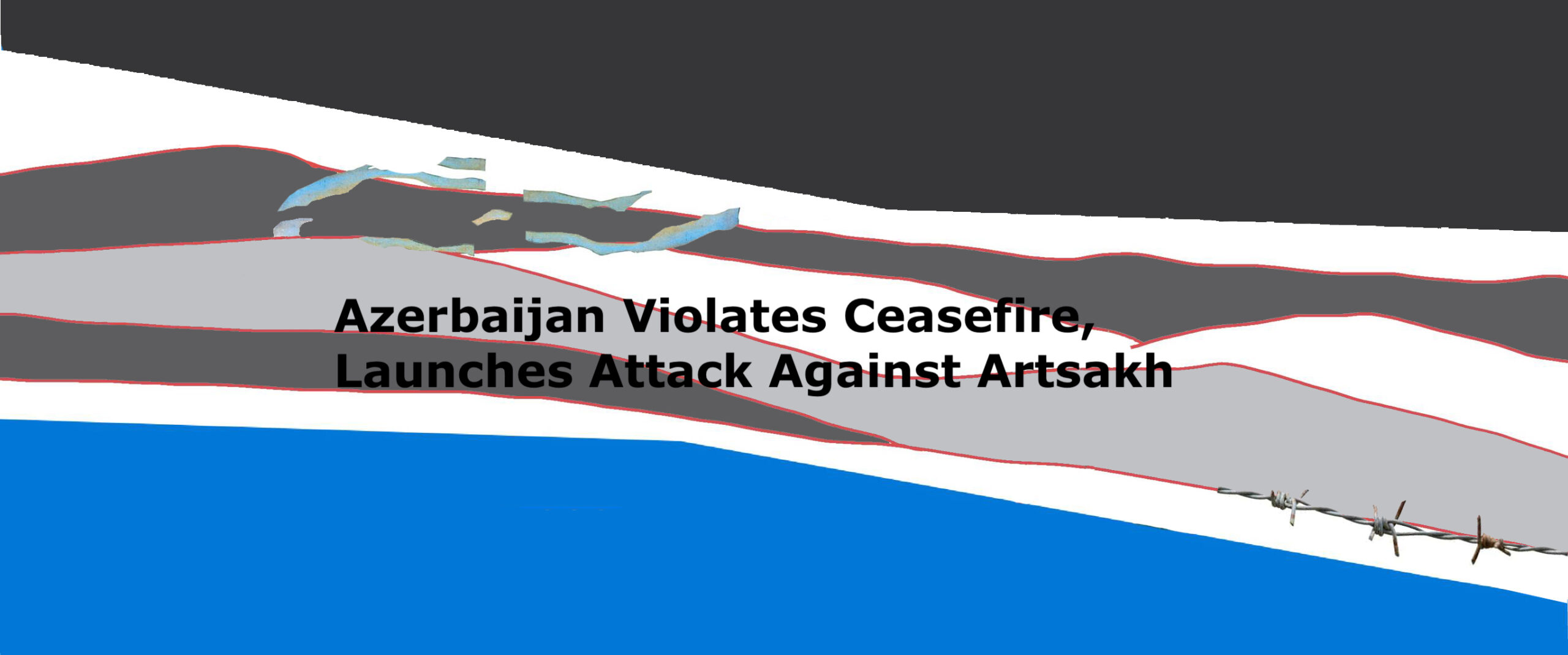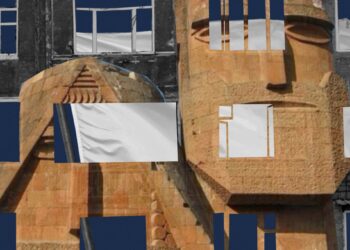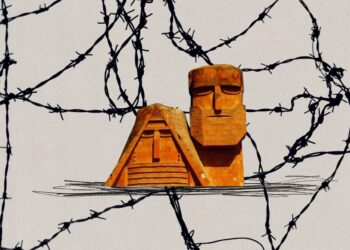
Two Armenian soldiers, Gurgen Gabrielyan and Artur Khachatryan, were killed and 19 others injured on August 3 after Azerbaijani Armed Forces launched an attack using drones, grenade launchers and anti-aircraft weapons in the Republic of Artsakh after days of mounting escalation.
According to the Artsakh Defense Army, in the early morning hours of August 1, Azerbaijani Armed Forces tried to breach the Line of Contact along the northern and northwestern border of the Republic of Artsakh. The incursion attempt was stopped by the Artsakh Defense Army and there were no losses reported as the situation remained tense. A soldier of the Defense Army, Albert Bakhshiyan, sustained injuries and was in stable condition.
The following day, on August 2, as of 9 a.m., the situation on the Line of Contact had not significantly changed. It remained “stable-tense,” according to the Artsakh Defense Army. The leadership of Artsakh, the Command of the Defense Army and the Russian peacekeeping troops initiated steps to defuse the situation and prevent further escalation. Artsakh’s President Arayik Harutyunyan convened a session of the Security Council with the participation of parliamentary political forces.
Armenia’s Prime Minister Nikol Pashinyan held a telephone call with Russian President Vladimir Putin after Baku demanded the closure of the Lachin Corridor, Artsakh’s sole lifeline with Armenia. The leaders spoke about the implementation of the November 9, 2020 trilateral ceasefire statement that ended the 2020 Artsakh War. No further details were provided.
Following the telephone conversation between Pashinyan and Putin, Russian Foreign Minister Sergei Lavrov spoke with Ararat Mirzoyan, Armenia’s Foreign Ministry. The two discussed the security situation in the region. Russia’s Defense Ministry reported later in the day that Defense Minister Sergei Shoigu phoned Azerbaijani Defense Minister Zakir Hasanov. In a short statement, the ministry said they spoke about regional security and “other topics of mutual interest.”
The Russian peacekeeping contingent also issued a statement in a bulletin on August 2, noting that Azerbaijani Armed Forces had violated the ceasefire regime three times in “the zone of responsibility of the Russian peacekeeping contingent” and stated that “changes in the contact line of the parties are not allowed.”
On August 3, starting from 9 a.m., Azerbaijani Armed Forces once again violated the ceasefire regime along the northwestern border of the Line of Contact, using grenade launchers and combat drones. As of 3 p.m, one Armenian soldier had been fatally wounded and eight others sustained injuries. It was announced once again that the Defense Army and the Russian peacekeeping mission stationed in Artsakh were taking steps to defuse the situation.
That same day, President Arayik Harutyunyan of Artsakh signed a decree, according to which partial military mobilization was declared in the Republic.
Gegham Stepanyan, the Human Rights Ombudsman of Artsakh tweeted that the Armenian side had two killed and 14 injured, many of whom sustained injuries by Azerbaijani drone strikes. The number of injured later reached 19. This was confirmed by Artsakh’s Health Minister Mikael Hayriyan.
Armenia’s Foreign Ministry issued a statement, calling out Azerbaijan for trying to unilaterally change the legal regime in the Lachin Corridor defined by provision 6 of the November 9, 2020 trilateral ceasefire statement, and reaffirming that the road passing through the Lachin Corridor can be changed only according to the plan approved by the parties to the statement. According to the foreign ministry, it is clearly defined by the November 9 statement, that within the next three years, the parties (Russia, Armenia and Azerbaijan) should determine the plan for the construction of a new road through the Lachin Corridor connecting Armenia with Nagorno-Karabakh, with the subsequent redeployment of Russian peacekeeping contingent for the protection of that road. The ministry underscored that there is no such plan approved within a trilateral format so far.
The statement also noted that the illegal incursion of the Azerbaijani Armed Forces in the direction of Parukh village on March 24 of this year, the attack on the Khtsaberd and Hin Tagher villages on December 11, 2020, in the area of responsibility of the Russian peacekeeping contingent are cases of similar aggression and violation of the ceasefire.The ministry stated that despite the steps undertaken by the Armenian side for achieving stability and peace in the region, Azerbaijan continues its pre-planned policy of terrorizing the population of Nagorno-Karabakh, subjecting them to ethnic cleansing and creeping occupation of Nagorno-Karabakh.
Armenia’s Foreign Ministry called on the international community to undertake measures toward halting the aggressive behavior and actions of Azerbaijan and to launch the necessary international mechanisms for that.
Artsakh’s Ministry of Foreign Affairs also issued a statement strongly condemning a new wave of aggression by Azerbaijan, qualifying them as “Armenophobia, as well as another brutal attempt to violate peace and stability in the region and discredit the peacekeeping mission.” The statement also called on the international community to call out the actions of the aggressor and “take adequate steps to restrain the destructive policy of official Baku.”
Meanwhile, the personal representative of the OSCE Chairperson in Office Andrzej Kasprzyk was in Yerevan and had a meeting with Foreign Minister of Armenia Ararat Mirzoyan today, who presented the security situation that has been unfolding in the region during the last several days. The Foreign Minister condemned the “arbitrary interpretation of trilateral statements and attempts to destabilize the situation by Azerbaijan, stressing the importance of the targeted assessments of the situation by the international community and, particularly, by the OSCE Minsk Group co-chairing countries.” Mirzoyan reiterated Armenia’s constructive position aimed at the normalization of relations between Armenia and Azerbaijan and the peaceful settlement of the Nagorno-Karabakh conflict was reiterated.
The OSCE Polish Chairmanship also tweeted the following: “We are extremely concerned about reported armed incidents and casualties in the South Caucasus. We urge Armenia and Azerbaijan to take all necessary measures to bring de-escalation and resume dialogue. We remain committed to supporting all efforts aimed at consolidating peace in the region.”
Amid reports on social networks about a strategic height being in contention, the Russian peacekeeping contingent, in a new bulletin on August 3, at 7 p.m., stated: “There is an aggravation of the situation in the zone of responsibility of the contingent. In the area of the height of Sarybaba, the ceasefire regime was violated by the armed forces of Azerbaijan. The command of the Russian peacekeeping contingent, together with representatives of the Azerbaijani and Armenian sides, are taking measures to stabilize the situation.”
Artsakh’s President Arayik Harutyunyan convened another sitting of the Security Council on the evening of August 3 to discuss the situation. During the session, Harutyunyan said: “Qualifying the actions being carried out by Azerbaijan against Artsakh since August 1 as a provocation, I noted that the necessary steps are being taken through the command staff of the Russian peacekeeping contingent deployed in Artsakh in order to de-escalate the situation and resolve it peacefully. Thus, I appeal to all our compatriots with the request to maintain restraint and calmness. We can record that at this stage there are certain changes in the de-escalation of the situation related to both the military situation and the Lachin Corridor.”
While the situation continues to remain fluid, the EU issued a statement calling for an “immediate cessation of the hostilities which have broken out between Azerbaijani and Armenian forces around the Lachin corridor and other places along the Line of Contact. Regrettably, these clashes already led to loss of life and injuries.” The statement went on to say that “It is essential to de-escalate, fully respect the ceasefire and return to the negotiating table to seek negotiated solutions.”
Artsakh’s Defense Army said that as of 6 p.m. on August 3, the situation along the Line of Contact between Nagorno-Karabakh and Azerbaijan is relatively stable.
Also read
Part I: What May Happen to Armenians in Nagorno-Karabakh
In Part 1 of a three-part series, Sossi Tatikyan analyzes the uncertainties and possible scenarios for Nagorno-Karabakh if Armenia’s leadership goes ahead with the recognition of Azerbaijan’s territorial integrity.
Read morePart II: What May Happen to Armenians in Nagorno-Karabakh
In order to understand what may happen to Armenians in Nagorno-Karabakh if appropriate international guarantees for security and human rights are not put in place for them, Sossi Tatikyan presents the evolution of several comparable conflicts.
Read morePart III: What May Happen to Armenians in Nagorno-Karabakh
In this next installment of a series on the Nagorno-Karabakh conflict, Sossi Tatikyan presents a way forward given the current situation to ensure security guarantees for the Artsakh Armenians and mark progress in the conflict’s resolution.
Read moreAzerbaijan’s Ongoing Policy of Ethnic Cleansing in Nagorno-Karabakh
Azerbaijan’s main goal is the removal of ethnic Armenians from Artsakh through the creation of conditions unfavorable for living, as well as creating an atmosphere of fear among the Armenian population.
Read more




